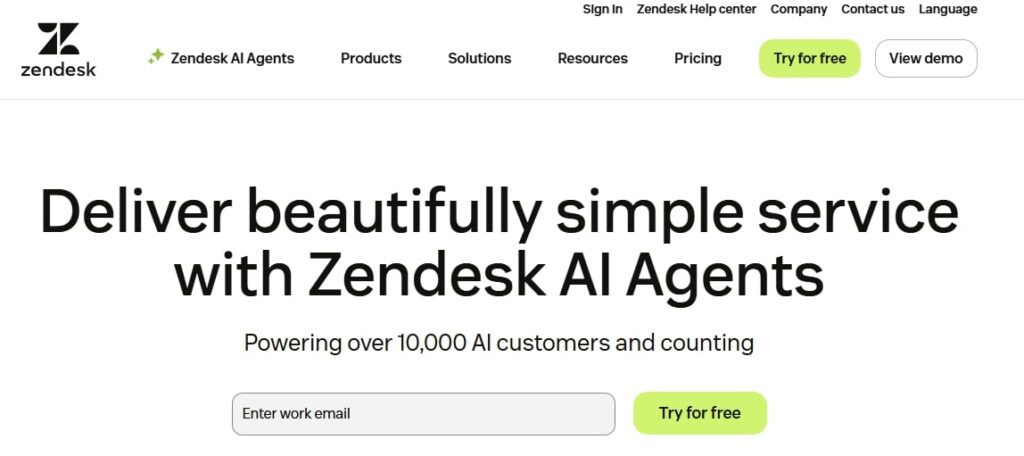Image via Zendesk
Zendesk is a customer service and sales CRM platform that helps you bring all your communication from every channel into one place.
It enables you to provide a consistent customer service experience across every channel. Your team can reply to everyone from their Zendesk account, rather than jumping across email, Messenger, WhatsApp, or any other channel.
Zendesk also offers various powerful features to help you manage support tickets and improve customer satisfaction and team productivity.
Let’s take a closer look before comparing Zendesk alternatives:
1. What are the pros of Zendesk?
Firstly, Zendesk makes it easy for your support team to get an overview of every open support ticket. The agent dashboard lets you jump between tickets based on the person who sent them and the topic they relate to. You can see which team members have been involved in the interaction.
This makes it easy for anyone to jump in, offer personalized support, and resolve tickets as quickly as possible.
Zendesk is also highly customizable. You can build custom workflows and set the platform up to match your unique business case based on your requirements. No matter how big your company gets, there will be a way to make Zendesk scale with you.
What’s more, Zendesk includes analytics tools that give you and your team insights into your customer service performance. You can see information on data such as:
- Number of total open tickets
- Number of chats
- Number of calls
- Customer Satisfaction Score (CSAT)
There’s no doubt that Zendesk is a powerful solution, especially for enterprise-size companies that need powerful features for managing customer communication.
2. What’s Zendesk missing?
Since Zendesk competes at the top end of the customer service market, it’s not fit for every company. It’s a tool designed for companies with large support teams, and both the features and pricing point reflect that.
Zendesk is more expensive than most Zendesk alternatives in the market, which makes it prohibitive for smaller companies to use and grow with.
The most basic pricing plan starts at $19 per month per seat (as shown below), and if you need more than the most basic features, you’ll be spending over $50 per month per seat you need. Even with a profitable, fast-growing company, the costs will add up fast.

Image via Zendesk
Another barrier to using Zendesk is that it requires a full shift from your existing inbox setup to using Zendesk as your hub for email activity. If you’re not ready to make that shift, there’s a chance that Zendesk will be an overkill for your business.
Also Read:
- Best email analytics platforms for client teams
- The crucial impact of response time on customer satisfaction
What are the best Zendesk alternatives?
Zendesk has been the go-to customer service and support platform, but it’s not the only option. Whether you’re looking for better pricing, customizable workflows, or niche support features, there are various Zendesk alternatives best suited for your needs.
Here’s an in-depth comparison of the top Zendesk alternatives to help you make the right choice:
1. timetoreply – Analytics solution for Gmail & Outlook
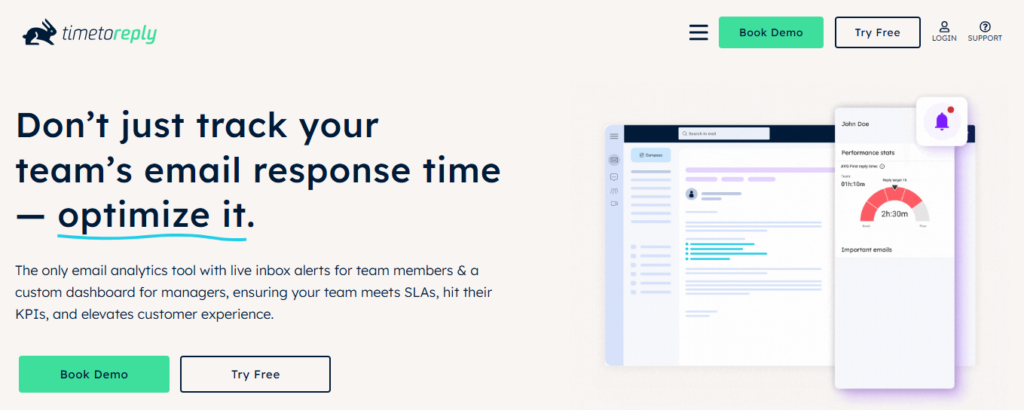
Image via timetoreply
First on our list of the best Zendesk alternatives is timetoreply. It’s an email analytics software for Gmail and Outlook. Once you connect timetoreply to your team’s email inboxes, it will start tracking your email activity and collecting analytics on usage. You’ll see data on every key email metric you need to know, such as:
- Average time to reply
- Average time to first reply
- Number of emails sent and received per day
Rather than replacing your email tool, timetoreply integrates with your current email system. You can track detailed performance metrics, including email response time SLAs, conversation tracking, and email productivity benchmarks.
You can create custom dashboards that show your team the key email activity metrics they need to know and schedule reports so you’re always up-to-date on your team’s performance.
Timetoreply also lets you set goals for email performance to ensure your customers and sales leads are never left waiting for a reply.
Another advantage for growing companies using timetoreply as their email response management software is that timetoreply offers both Gmail and Outlook email analytics, as well as other inboxes.
Looking for the best Zendesk alternatives? Try timetoreply for free
In terms of our responsiveness, it’s gone up from 62% to 86% as a company.
What makes timetoreply different?
Timetoreply stands out as one of the top Zendesk alternatives for a few reasons:
- Works with any inbox: Connect timetoreply to Gmail, Outlook, or any other mailbox and start collecting and tracking your email response time data in minutes
- Powerful analytics: Track every key metric on your team’s email activity and productivity to ensure client expectations are always met
- Goal setting and SLA management: Set goals and track performance to motivate your team and generate results
- Works from your existing inbox: You don’t need to shift to a new email platform. timetoreply works with your existing account so your team doesn’t get disrupted.
- Internal benchmarking: Compare email response rates and times across support teams and individuals for performance coaching.
Pros
- Works with existing inboxes
- Offers granular analytics and insights
- Lightweight alternative to heavy help desk software
- Improves customer response and streamlines communication
- Great for remote and hybrid teams
Cons
- Email-focused customer support
Pricing
timetoreply offers transparent pricing with multiple tiers based on your needs.
- Pro: $25 per mailbox/month (billed annually)
- Elite: $34 per mailbox/month (billed annually)
- Premier: Pricing is provided upon request

Image via timetoreply
Tool level
- Beginner to intermediate
Usability
- Incredibly easy to set up and use
Pro tip: Use data from timetoreply analytics to establish achievable service level agreements for email responses and improve customer experience.
2. Email Meter

Image via Email Meter
Email Meter is also one of the top Zendesk alternatives on our list. It’s an email analytics tool for Gmail and Microsoft 365 designed to give your team actionable insights into your email performance.
It tracks data points such as:
- Average response time
- Minimum and maximum response times
- Number of emails sent and received
Email Meter is exclusively designed to offer Microsoft 365 and Gmail email analytics and won’t work with other inbox providers. Like timetoreply, you won’t need to install any software on your devices to use Email Meter, as it’s a cloud-based email management solution.
Email Meter is one of the best Zendesk alternatives for businesses that don’t need a full ticketing system but want clear visibility into how their email communications are performing.
However, like Zendesk, Email Meter is best for enterprise companies, as the most powerful features are limited to their highest pricing plan.
Key features
- Email analytics: Detailed reports and graphs to help you understand your email response time, volume, traffic, and peak times.
- Track performance: Compare individual performance vs. average company performance
- Cloud-based: No software installation is required as it’s a cloud-based solution.
- Easily shareable: Export reports to CSV files
- Reporting: Use real-time reports or schedule them to run at set intervals
See how Email Meter compares to Timetoreply here.
Pros
- Easy to set up and use
- Integrates smoothly with Gmail and Google Workspace
- Provides detailed metrics and actionable insights into email performance
- Ideal for teams managing large inbox volumes
- Doesn’t require a ticketing system
Cons
- Focuses on email analytics only
- Limited automation features
Pricing
Email Meter offers a free plan and two pricing packages.
- Free plan: $0 for basic email analytics
- Plus: $19 per user/month
- Custom Dashboard: Pricing is provided on request
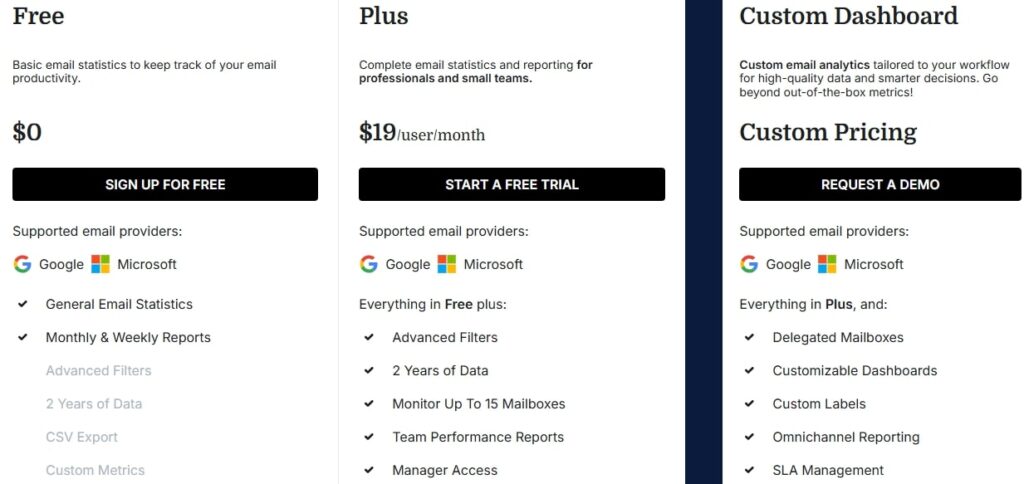
Image via Email Meter
Tool level
- Beginner to intermediate
Usability
- Easy to use
Pro tip: Customize reports to track specific metrics that are most relevant to your goals.
3. Email Analytics
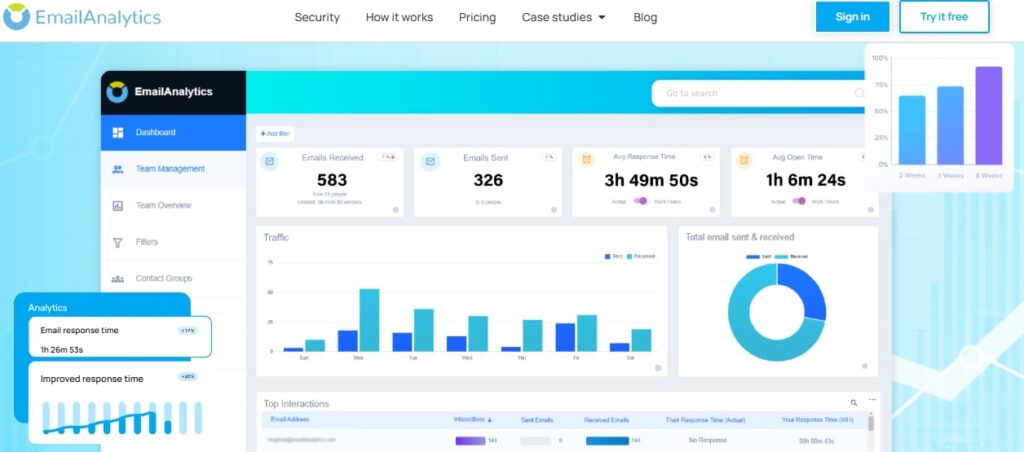
Image via EmailAnalytics
Email Analytics is an Outlook and Gmail analytics tool that helps you understand your team’s email activity and performance. Like Email Meter, it only works for Gmail and Outlook users. Once you connect your team’s accounts, it will start collecting data and compiling it into actionable data visualizations.
It provides insights into key standard email response times, email volume, and team workload. It’s one of the top-rated Zendesk alternatives for monitoring your team’s email activity and using that data to improve response times and agent productivity.
There are currently no goal-setting features built into Email Analytics like there are with timetoreply. However, it’s one of the top-rated Zendesk alternatives you can use to get a clear understanding of your current email performance.
All in all, it’s a solid option if you’re looking for Zendesk alternatives that offer features around email response tracking.
Key features
- Email response time monitoring: Track email response times across your company and see performance on a team or individual basis.
- Email volume metrics: Track the number of customer service emails sent and received daily, weekly, or monthly.
- Agent performance monitoring: Track and identify agents with the fastest email response times and highest email volumes.
- Team and individual reports: Compare individual and team email performance.
- Cloud-based: No need to download software.
- User management: Add or remove users from Email Analytics in a few clicks.
See how Email Analytics compares to timetoreply here.
Pros
- Easily integrates with major email providers
- User-friendly dashboards
- Offers in-depth email performance insights
- More affordable compared to Zendesk
- Ideal for hybrid and remote teams
Cons
- Email-only analytics
- Lack of built-in response or collaboration tools
- Limited support features
Pricing
With Email Analytics, you get two pricing plans and a 14-day free trial included in the first tier.
- Pro: $13.5 per inbox/month (Includes a 14-day trial)
- B2B Email Outreach: $1500 per month
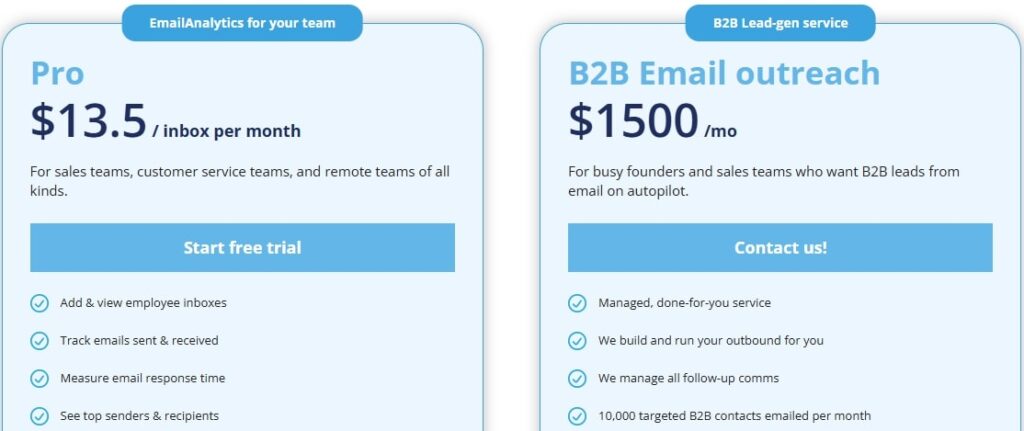
Image via EmailAnalytics
Tool level
- Beginner to intermediate
Usability
- Easy to set up and operate
Pro tip: Combine email insights with CRM data to get a holistic view of your customer service performance.
Also Read:
- Maximizing email productivity: Strategies, tools, and best practices
- Tips for improving your first contact resolution rate
4. Freshdesk
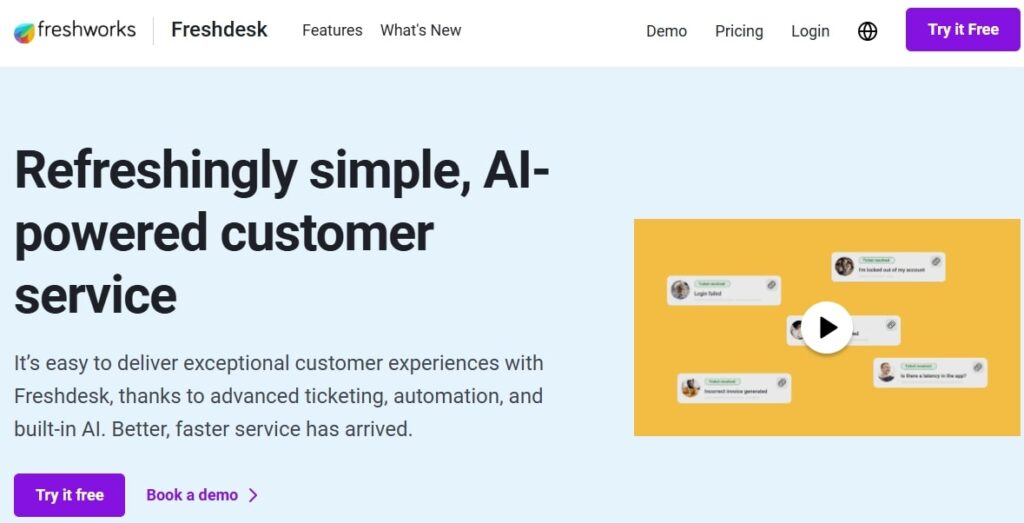
Image via Freshdesk
Freshdesk, developed by Freshworks, is a customer service and ticketing platform similar to Zendesk. It’s one of the best Zendesk alternatives that offers omnichannel support, advanced automation, AI-powered features, and an intuitive ticketing system.
Like with Zendesk, you’ll need to integrate it with your email accounts and support channels. Then, you’ll manage all your communications from the platform and won’t need to reply to emails from your regular Gmail or Outlook inbox.
You should also consider if you need a standalone system to manage your customer service needs. If you’re not ready to migrate your entire team’s day-to-day support work onto the platform, it’s best to explore other Zendesk alternatives.
On the other hand, if you need a tool similar to Zendesk but at a more affordable price point, Freshdesk is one of the most budget-friendly Zendesk alternatives.
Key features
- Unified support hub: Bring all your customer service channels into one dashboard with a multi-channel ticketing system.
- AI-powered chatbot: Freddy AI offers automated responses, ticket deflection, and support predictions using machine learning.
- Analytics: Tracks your agent and group performance metrics against benchmarks.
- Self-service portal: Create and manage knowledge base articles, FAQs, and tutorials to reduce ticket volumes.
- App marketplace: Add functionality to your help desk with thousands of apps.
- Reporting: Create custom dashboards, automate workflows, schedule reports, and monitor your help desk performance continuously.
Pros
- User-friendly interface
- Affordable pricing compared to Zendesk
- Strong automation and AI tools
- Scalable solution for growing customer service teams
- Integrates with countless business applications
Cons
- Freddy AI is only available on premium plans
- Can get expensive as you scale
- Its features can be overwhelming for small teams with simple requirements
Pricing
Freshdesk offers several pricing tiers, each with a free trial valid for 14 days.
- Growth: $18 per agent/month
- Pro: $59 per agent/month
- Pro + AI Copilot Bundle: $94 per agent/month
- Enterprise: $95 per agent/month
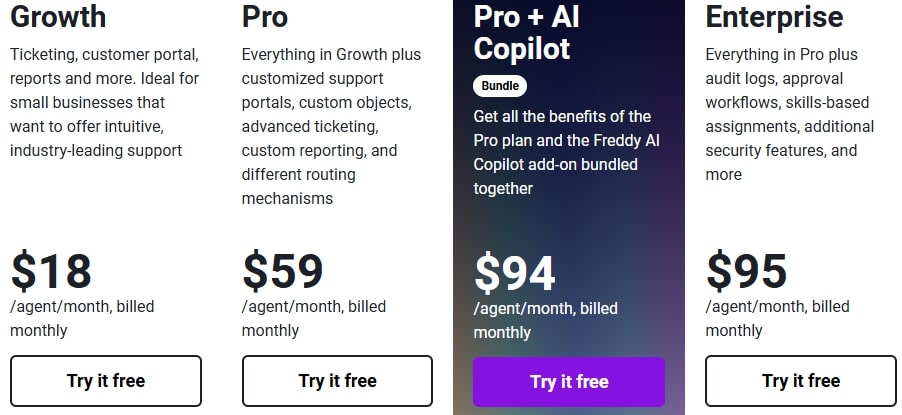
Image via Freshdesk
Tool level
- Beginner to advanced
Usability
- Easy to onboard and scale
Pro tip: Automate repetitive tasks to improve efficiency and free up agents to handle more complex issues.
5. Front
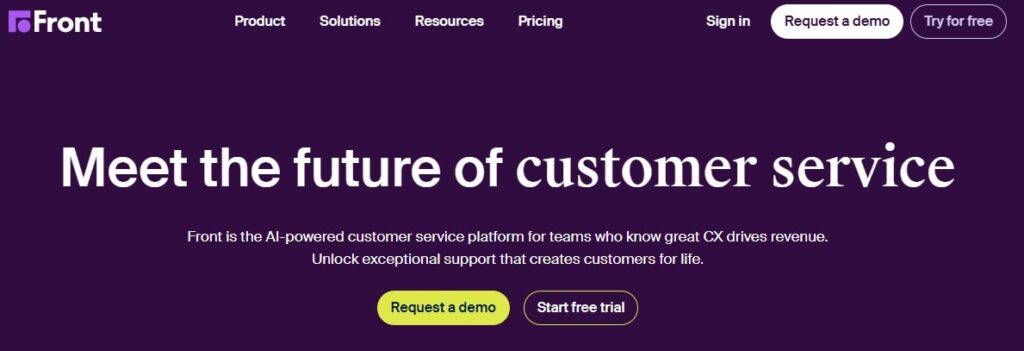
Image via Front
Front is an email management platform that brings all your company email communication into one place, from sales to customer service, and your internal team emails.
It’s one of the Zendesk alternatives that allow multiple team members to manage, assign, and respond to emails, SMS, live chat, and social media messages from a unified inbox.
Like Zendesk, Front requires your company to move all your email communication onto the platform. You can also connect social media and phone numbers to manage incoming support messages on those channels.
It’s one of the best Zendesk alternatives that can save your support team from switching between channels throughout the day.
Front’s analytics feature is available on higher pricing tiers. You can measure your email response times, inbox volume, and trends in your inbox to help you ensure your email accounts are being monitored at peak hours.
However, it’s not one of the Zendesk alternatives designed as analytics platforms. The data isn’t as detailed as it is in tools like timetoreply, Email Meter, and Email Analytics.
Front integrates with various tools, so you can customize your workflow as much as you need to.
There’s no doubt that Front is a powerful platform for teams that need to unify their customer communication into one shared inbox.
It’s one of the top Zendesk alternatives for businesses that combines modern workflow tools with a customer-first approach.
Key features
- Shared inboxes: Handle all customer-facing communication from one place and give all your support agents access.
- Rules and automation: Set up workflows to automate tasks like routing important emails to specific team members or departments.
- Collaborate on email threads: Your team can leave comments and messages inside email threads to help team members gather context.
- Analytics and insights: See data on your email response times, support team performance, and track SLA adherence.
- Knowledge base integration: Connect with knowledge base platforms to easily access and share relevant articles with customers.
See how FrontApp compares to timetoreply here.
Pros
- Excellent team collaboration tools
- Unified view of all customer interactions:
- Knowledge base streamlines customer service management
- Improves team communication and transparency
- Integrates seamlessly with other tools
Cons
- Steep learning curve for advanced workflows
- Can become costly for large teams
Pricing
Front offers tiered pricing plans and a free trial on the Starter package.
- Starter: $29 per seat/month for 10 seats
- Growth: $79 per seat/month for 35 seats
- Scale: $99 per seat/annually for a minimum of 2 seats
- Premier: Custom pricing provided on request

Image via Front
Tool level
- Intermediate to advanced
Usability
- Fairly easy to use
Pro tip: Organize your inboxes by team, channel, or function to ensure efficient routing and visibility.
6. Gorgias
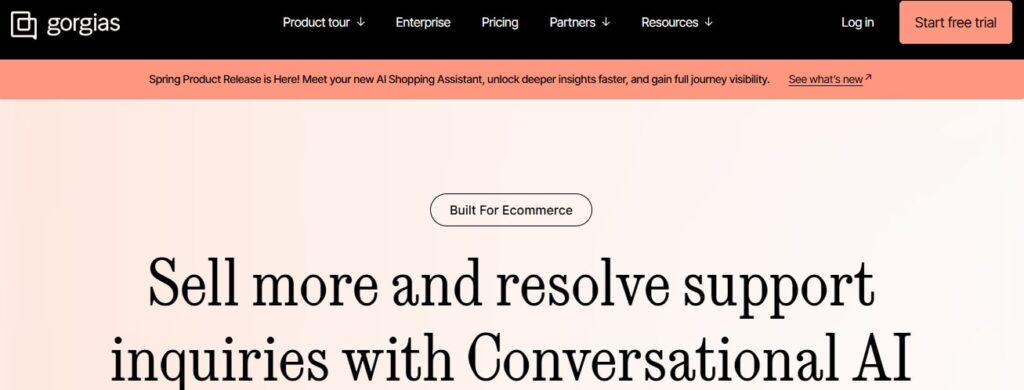
Image via Gorgias
Gorgias is an ecommerce help desk specifically designed for ecommerce businesses. It’s one of the most powerful Zendesk alternatives if you need advanced features to manage a high volume of customer service tickets.
Once you integrate Gorgias with your ecommerce website and other customer communication channels (Instagram, Facebook, Klaviyo, email, and more), you’ll start receiving all your messages in one place. Gorgias will also use the customer details to cross-reference them with past orders in your database, so your team has full context whenever they’re talking to customers.
In terms of email analytics, Gorgias stands out from most Zendesk alternatives. It compiles your metrics on your support team’s response time, ticket resolution time, ticket efficiency, peak hours, and more.
Gorgias is a powerful option, but it’s also one of the most expensive Zendesk alternatives, starting at $60 per month. Like Zendesk, it also requires you to migrate all your email activity onto the platform to get the most out of it. This means going through an onboarding period before your team can reach full productivity again.
Key features
- Ecommerce integrations: Works with Shopify, Magento, and WooCommerce and brings in your customers’ order history.
- Multichannel support: Bring all of your customer service channels into one dashboard.
- Unlimited users: Price is based on the number of tickets rather than the number of users.
- Email analytics: Provides analytics on key customer service metrics that you can use to improve your support team’s workflow.
- Rule-based automation: Automatically tag, assign, and respond to tickets based on customer intent, keywords, or actions.
- Customer history timeline: View all past interactions and orders in a unified thread for personalized support.
Pros
- Integrates with ecommerce platforms
- Powerful automation capabilities
- Tracks support-driven revenue
- Centralizes communication across multiple channels
- Simplifies order management
Cons
- Less suitable for non-ecommerce businesses
- Pricey as ticket volume scales
- No free plan
Pricing
Gorgias offers volume-based pricing, depending on the number of tickets per month. A free 2-month trial is only available with annual billing.
- Basic: $60 per month for 300 tickets
- Basic (20% automation): $120 per month for 300 tickets and 60 automated tickets
- Basic (30% automation): $160 per month for 300 tickets and 90 automated tickets
- Basic (50% automation): $210 per month for 300 tickets and 150 automated tickets

Image via Gorgias
Tool level
- Beginner to intermediate
Usability
- Easy to use
Pro tip: Use intent detection and autoresponders to instantly answer common FAQs and save agent time.
Also Read:
- Why your business needs quick customer replies (+ four strategies to get there)
- How to use data to improve email response times effectively
7. Help Scout
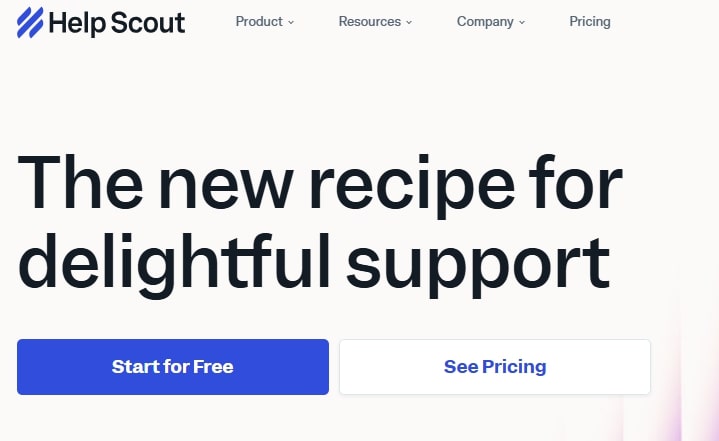
Image via Help Scout
Help Scout is a help desk designed to make it as easy as possible for your team to help your customers. It’s one of the most user-friendly Zendesk alternatives that simplifies customer service management. Once you’re set up, you can reply to customer emails and support tickets in your Help Scout inbox.
All of your support emails are added to a shared inbox, which makes it easy for any agent on your team to quickly reply to a conversation and improve customer satisfaction.
There’s an API that allows you to connect Help Scout to other business software and ensure all the information your team needs is at their fingertips.
To help you understand your email performance, there are analytics that you can look at to assess performance around metrics such as total conversations per day, new conversations, and more.
Help Scout is one of the lightweight and accessible Zendesk alternatives if you need a standalone support hub for your business.
Key features
- Support analytics: See key metrics on your support volume to help your team manage workflows
- Lightweight: Designed to be more streamlined than Zendesk, making it a feasible option for smaller companies
- Shared inboxes: Create shared email inboxes and give your whole team access so someone is always available to reply when a customer or sales lead reaches out
- Knowledge base: Create a centralized hub for knowledge base articles, FAQs, and tutorials to help customers find relevant information.
- Live chat: Embed a customizable chat widget (Beacon) that allows customers to message support agents directly.
- Reporting and analytics: Leverage visual dashboards to track productivity, conversation volume, reply times, and more.
Pros
- Very easy to use
- Offers collaboration features like in-app messaging and shared inboxes
- The live chat tool lets users chat or access help articles easily
- Focuses on personalized customer support
- Enables self-service
Cons
- Lacks some advanced features for large enterprises
- Less advanced automation capabilities
Pricing
Help Scout offers a free plan and three paid plans.
- Free Plan: $0 for up to 50 contacts
- Standard: $55 per month for 100 contacts and unlimited users
- Plus: $83 per month for 100 contacts and unlimited users
- Pro: Custom pricing available on request
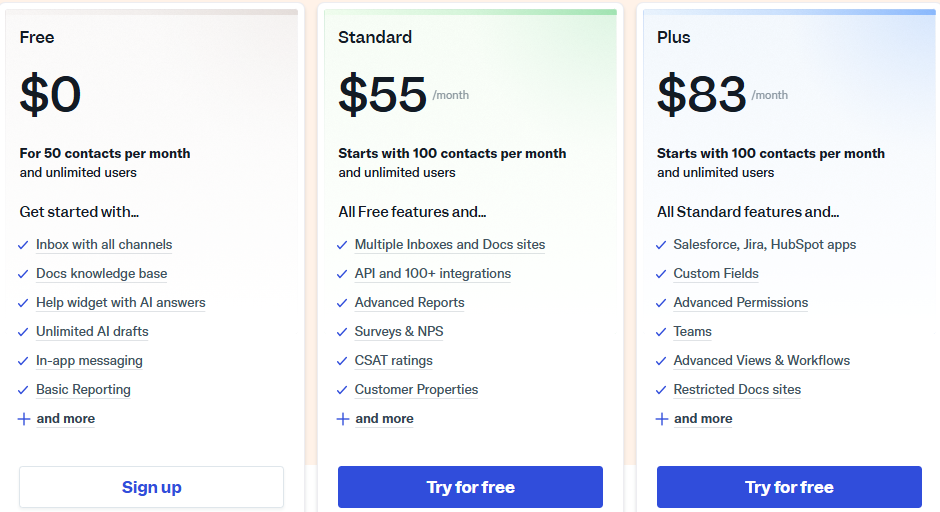
Image via Help Scout
Tool level
- Beginner to intermediate
Usability
- Incredibly easy to use
Pro tip: Instead of emailing teammates, use internal notes in the conversation thread to ask questions, provide context, share updates, and collaborate directly on a customer issue.
8. Zoho Desk
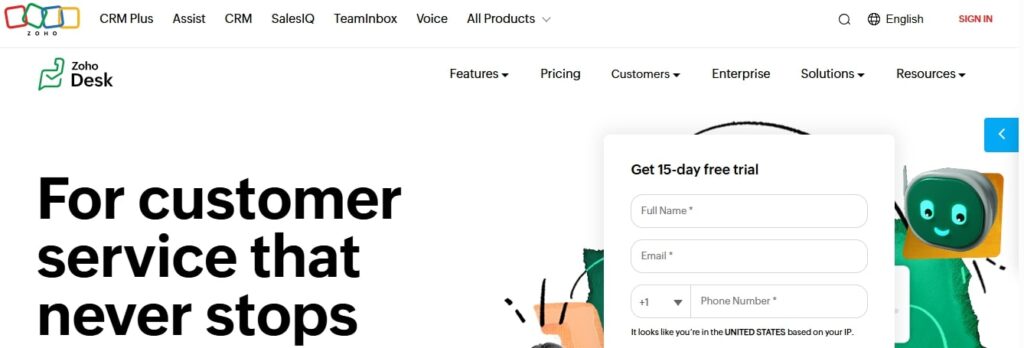
Image via Zoho Desk
Zoho Desk is part of the comprehensive Zoho suite of business tools. This makes it one of the best Zendesk alternatives to consider if you’re looking for deep integration capabilities.
Zoho Desk integrates seamlessly with other Zoho business tools like Zoho CRM, Zoho Analytics, and Zoho Projects. This cloud-based help desk solution enables you to deliver efficient and timely customer service across multiple channels.
It’s also one of the top Zendesk alternatives with advanced AI-driven automation and customizable workflows.
Key features
- Offers multi-channel support: Manage customer interactions across email, live chat, phone, social media, and web forms from a unified platform.
- AI-powered assistant (Zia): Zia analyzes customer sentiment, suggests ticket responses, detects anomalies, and even automates repetitive tasks.
- Context-aware ticketing: Analyze customer data from Zoho CRM or other apps to provide personalized support.
- Custom SLAs and workflows: Define email and customer service SLAs, auto-assign customer support tickets, and create automation rules.
- Self-service portals: Create a branded help center with FAQs, knowledge base articles, and forums.
- Advanced analytics and reports: Visual dashboards and detailed metrics help you monitor team performance and customer satisfaction.
Pros
- Excellent integration with the Zoho ecosystem
- Highly customizable dashboards and reports
- Affordable pricing
- User-friendly interface
- Great automation capabilities
Cons
- Limited third-party integrations outside the Zoho ecosystem
- Moderate learning curve for complex customizations
- Lacks deeper enterprise-grade features
Pricing
Zoho Desk offers four paid tiers, each with a free trial.
- Free Trial: 15-day trial for all plans
- Express: $9/per user/month
- Standard: $20/per user/month
- Professional: $35/per user/month
- Enterprise: $50/per user/month
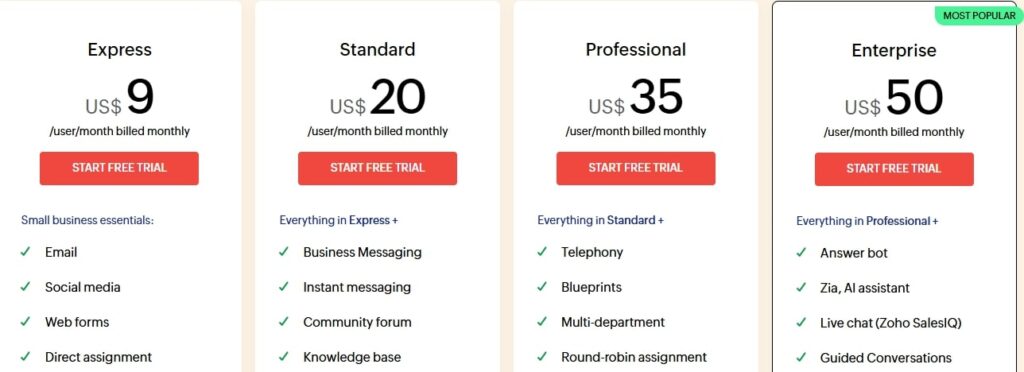
Image via Zoho Desk
Tool level
- Intermediate to advanced
Usability
Zoho Desk is fairly easy to use if you’re just looking for basic features. Custom modules and workflows can be complex and require training.
Pro tip: Utilize Zia’s AI-powered suggestions, sentiment analysis, and automation to improve response times and enhance the overall customer experience.
9. Salesforce Service Cloud
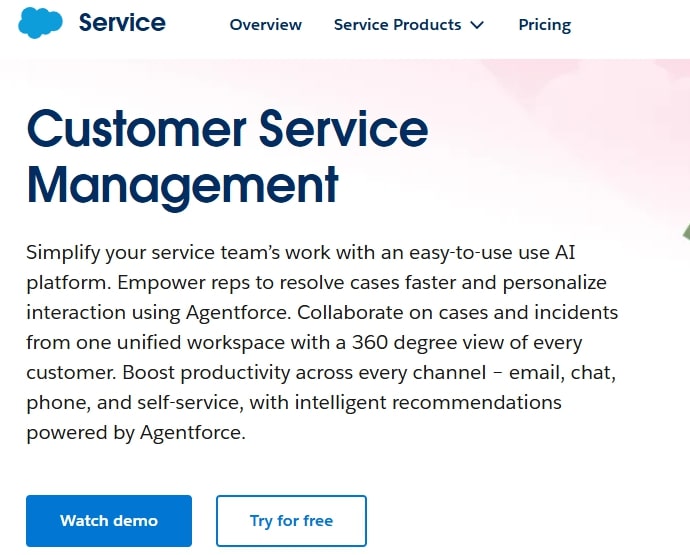
Image via Salesforce Service Cloud
If you’re looking for an enterprise-grade customer service (CRM) platform, Salesforce Service Cloud is one of the top Zendesk alternatives you can choose.
It centralizes customer support, sales, and automation under one robust CRM ecosystem. Salesforce allows you to deliver fast, personalized, and connected service across every customer touchpoint.
Compared to Zendesk, this customer support software offers deeper insights into customer service analytics that you can leverage to build stronger customer relationships and improve satisfaction.
Salesforce differentiates itself from other Zendesk alternatives by offering highly personalized customer service and support.
Key features
- Case management: Create, assign, prioritize, and resolve customer support requests with automation and workflows.
- Omnichannel support: Manage customer interactions across multiple channels from a single console.
- Einstein AI: Uses artificial intelligence to suggest next-best actions, auto-classify cases, and provide knowledge article recommendations.
- Self-service communities: Let customers access self-service support, knowledge bases, and community forums through branded portals.
- Live agent chat and chatbot integration: Combine human support with automated bots to enable real-time customer engagement.
- Field service: Schedule, dispatch, and monitor field technicians directly from the platform.
Pros
- Unified Customer Relationship Management (CRM) platform
- Highly scalable and customizable
- Advanced AI analytics and reporting tools
- Excellent automation capabilities
- Strong community and support features
Cons
- Expensive for small businesses
- Requires technical configuration
- Steep learning curve
Pricing
Salesforce Service Cloud comes with several pricing plans.
- Starter Suite: $25/per user/month
- Pro Suite: $100/per user/month
- Enterprise: $165/per user/month (billed annually)
- Unlimited: $330/per user/month (billed annually)
- Einstein 1 Service: $500/per user/month (billed annually)
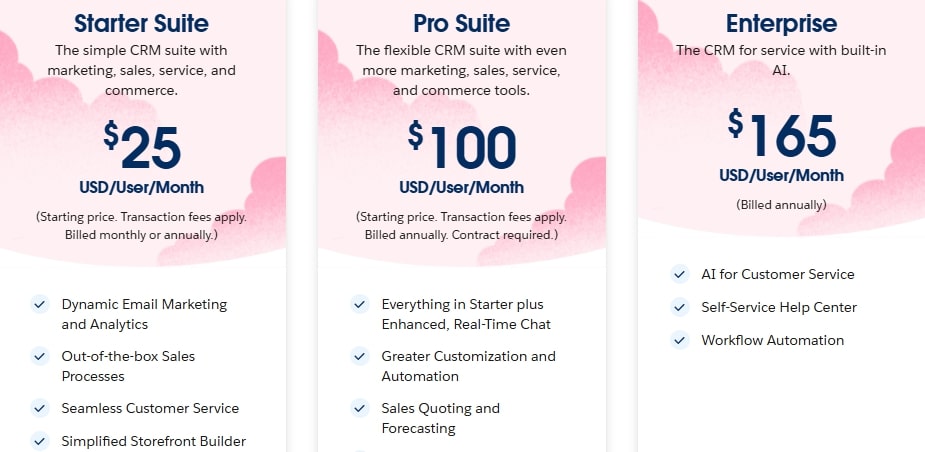
Image via Salesforce Service Cloud
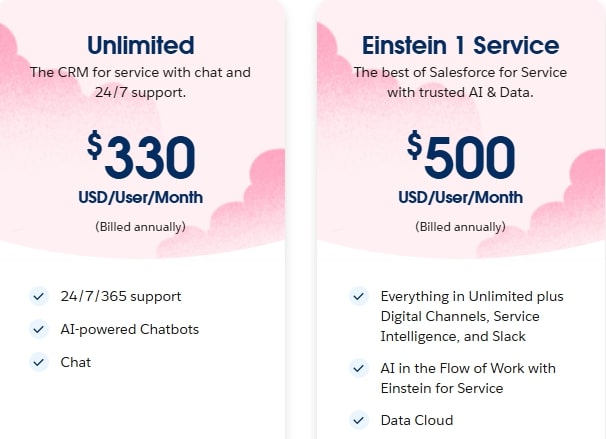
Image via Salesforce Service Cloud
Tool level
- Enterprise
Usability
Salesforce Service Cloud has a complex UI and requires technical training.
Pro tip: Leverage Salesforce’s free learning portal to help your team learn everything from basic navigation to advanced automation.
Also Read:
- Customer service analytics guide for sales and customer teams
- How to effectively manage email for remote work
10. HubSpot Service Hub
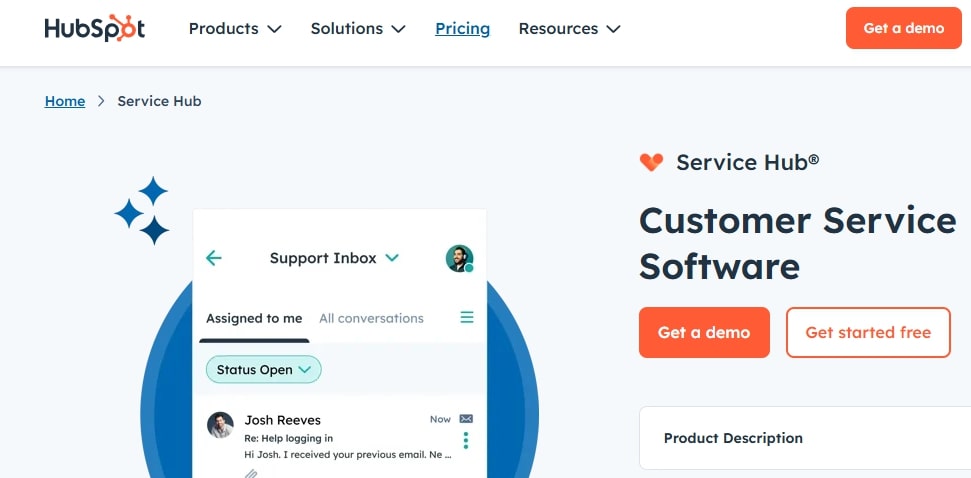
Image via HubSpot Service Hub
Next on our list of the best Zendesk alternatives is HubSpot Service Hub. It’s a customer support software built as a part of the larger HubSpot CRM platform.
Unlike standalone customer support tools like Zendesk, HubSpot Service Hub works natively with your CRM, marketing automation, and sales tools. This enables customer support teams to access complete histories and provide faster, more personalized responses to customer inquiries.
Compared to Zendesk, HubSpot Service Hub equips support teams with tools to manage customer conversations across various channels, automate support processes, and deliver a personalized customer experience.
Key features
- Ticketing system: Easily assign, track, and manage tickets by organizing them by priority, pipeline, or status.
- Shared inbox: A universal inbox provides your customer agents with visibility into all customer interactions across email, live chat, and bots.
- Live chat and chatbots: Automate initial customer interactions, answer queries, and route customer conversations to the appropriate support agents.
- Knowledge base: Create a searchable, self-service library of articles, FAQs, and guides that enable customers to easily find solutions.
- Automation and workflows: Automate repetitive tasks like ticket routing, follow-up emails, and customer feedback collection using HubSpot’s workflow builder.
- Customer feedback: Create and send customer satisfaction surveys to gather feedback. Analyze the results to identify areas for improving service quality.
Pros
- Unified platform for customer support, marketing, and sales
- Easy to use with HubSpot CRM
- Excellent knowledge base and self-service tools
- Free tools available
- In-depth reporting and analytics
Cons
- Premium customer support features come at a high cost
- Limited customization in lower tiers
- Too basic for complex enterprise support
Pricing
HubSpot Service Hub offers a tiered pricing model with per-seat costs for paid plans.
- Free plan: $0 per month
- Starter: $20 per seat/month
- Professional: $100 per seat/month
- Enterprise: $150 per seat/month

Image via HubSpot Service Hub
Tool level
- Beginner to intermediate
Usability
- Easy to use
Pro tip: Integrate with HubSpot Service Hub to access full customer lifecycle data and deliver a truly unified customer experience, combining sales and marketing automation.
11. LiveAgent
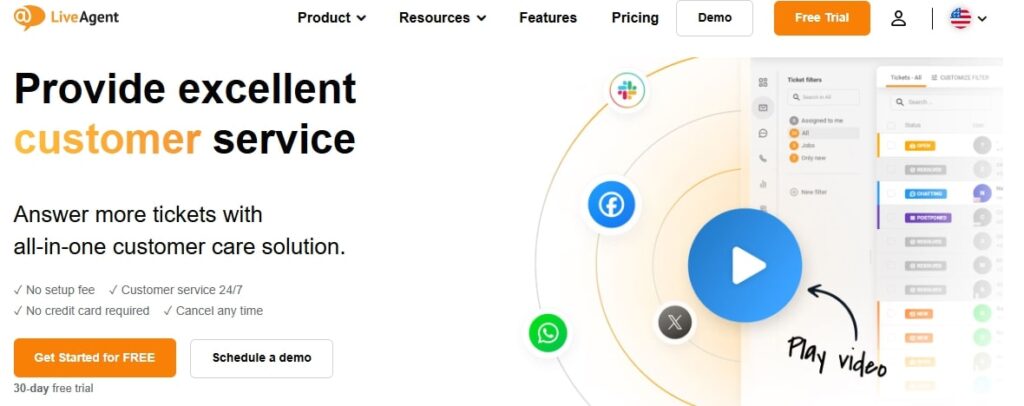
Image via LiveAgent
LiveAgent is a customer service management platform that coordinates customer communications across multiple channels from a single interface.
It stands out as one of the top-rated Zendesk alternatives for its omnichannel capabilities, efficient ticket management, and extensive integrations.
It is one of the best Zendesk alternatives for small to mid-sized businesses seeking multi-channel customer support at a budget-friendly price.
Key features
- Universal inbox: Your customer support agents can manage all email, live chat, call center, and social media messages from a unified dashboard.
- Ticket management system: Organize and track customer inquiries with automation rules, tags, statuses, and filters.
- Live chat widget: Engage with your website visitors in real-time, exchange files, and route customer conversations to available customer support agents.
- Built-in call center: Features like Interactive Voice Response (IVR), call routing, and recordings enable you to make and receive calls directly on the platform.
- Gamification features: Motivate customer support agents with badges, leaderboards, and achievement tracking.
- Social media integration: Connect Facebook, X, Instagram, and other platforms to handle customer inquiries and comments.
Pros
- Affordable pricing tiers
- Excellent live chat performance
- Customizable automated workflows
- Omnichannel support in one dashboard
- Well-structured ticketing system
Cons
- Learning curve for advanced features
- Outdated interface compared to Zendesk
- Lacks advanced analytics and reporting features
Pricing
LiveAgent offers a tiered pricing structure with four plans. The first three plans include a free trial:
- Free trial: 30-day trial on three packages
- Small business: $15 per agent/month (billed annually)
- Medium business: $29 per agent/month (billed annually)
- Large business: $49 per agent/month (billed annually)
- Enterprise: $69 per agent/month (billed annually)
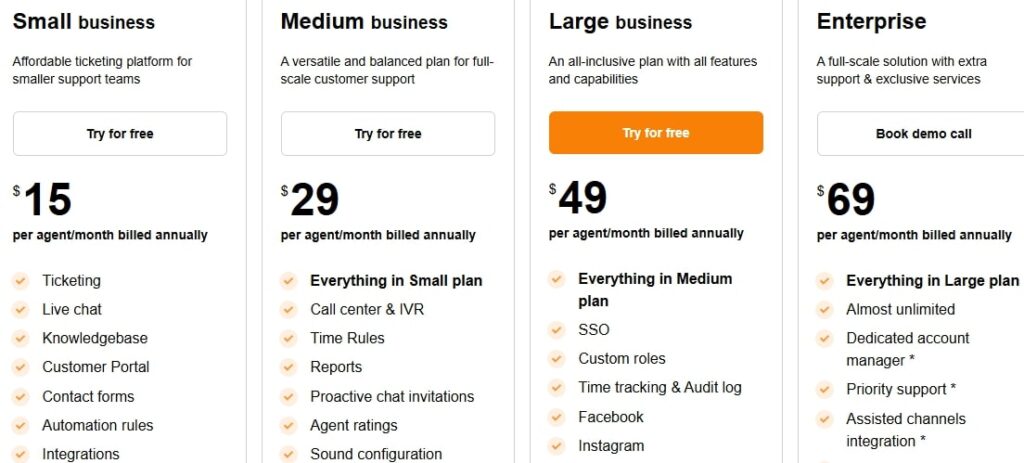
Image via LiveAgent
Tool level
- Beginner to intermediate
Usability
- The system is simple to use once set up, but the user interface is somewhat outdated.
Pro tip: Gamify your customer service operation using badges and leaderboards to motivate customer support agents, maximize engagement, and increase productivity.
Also Read:
- How to make your business more productive: quick tips
- Common email marketing challenges and their solutions
12. HappyFox
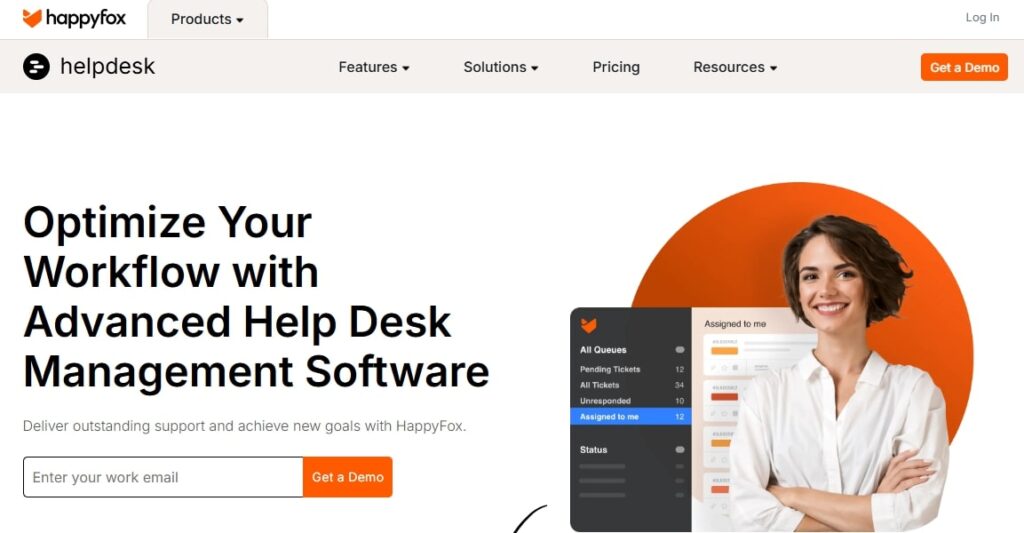
Image via HappyFox
As one of the most unique Zendesk alternatives, HappyFox is an intuitive help desk solution that can help you streamline customer support operations and enhance agent productivity.
It’s a great fit if you’re looking for a platform with a clean UI, automated workflows, and multi-channel support.
This customer communication platform made it to our Zendesk alternatives list for its strong emphasis on automation features and centralized hub. It enables you to manage customer data across multiple channels and deliver a seamless customer experience.
Key features
- Multi-channel ticketing system: Organize and manage customer inquiries from web forms, email, and social media.
- Smart rules and automation: Create trigger-based automation rules for ticket routing, escalation, status updates, and response time SLAs.
- Customizable ticket fields and forms: Tailor your ticket interface to capture relevant customer information.
- Self-service portal and knowledge base articles: Create a branded support portal that allows customers to access articles, FAQs, tutorials, and forums.
- Agent productivity tools: Use pre-written (canned) responses, add internal notes to tickets, and break down complex customer requests to enhance collaboration and productivity.
- Pre-built reports: Access custom reports and dashboards with metrics like ticket volume, first contact resolution rate, agent performance, and customer satisfaction.
Pros
- Strong automation capabilities
- Clean, user-friendly interface
- Strong customization and automation features
- Reliable knowledge base and self-service tools
- Responsive customer support
Cons
- Limited integrations compared to Zendesk
- Lacks a free plan
- Slight learning curve for advanced customization
Pricing
HappyFox offers four pricing packages based on the features included.
- Basic: $29 per user/month
- Team: $69 per user/month
- Pro: $119 per user/month
- Enterprise Pro: Pricing available on request
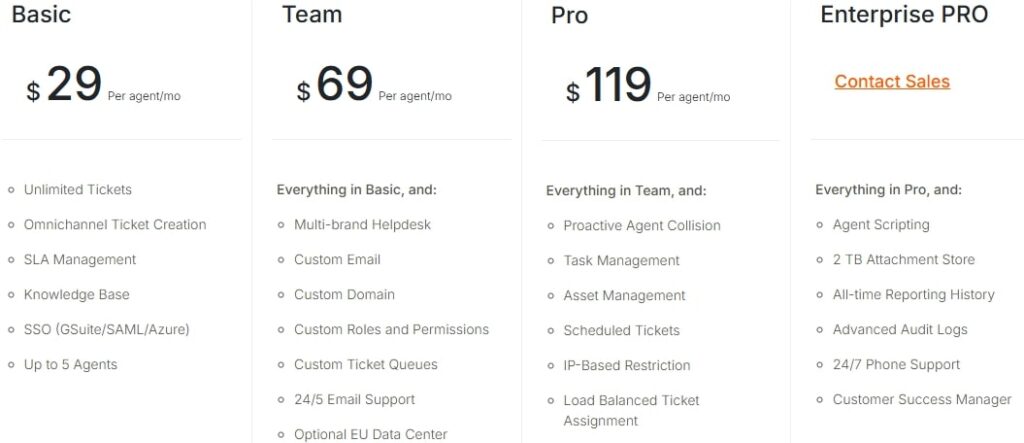
Image via HappyFox
Tool level
- Intermediate to advanced
Usability
- Easy to navigate
Pro tip: Utilize canned responses to quickly resolve common customer inquiries and enhance the overall customer experience.
13. Kustomer

Image via Kustomer
Kustomer stands out from other Zendesk alternatives for its CRM-first approach to customer service. Unlike traditional help desks that treat each ticket as a separate interaction, Kustomer focuses on the entire customer journey.
This help desk solution provides customer support agents with a comprehensive and contextual view of every customer’s history across all channels. This enables them to anticipate customer needs and offer a personalized customer experience.
Key features
- 360-degree customer view: Displays all past conversations, transactions, orders, returns, and support interactions in a single stream.
- Multi-channel support: Integrates seamlessly with email, live chat, SMS, WhatsApp, Facebook Messenger, Instagram, and voice in one inbox.
- CRM and ecommerce integration: Connects with CRM systems and ecommerce platforms to pull in customer data, purchase history, and other relevant information.
- Automated workflows: Use conditions and triggers to automate routing, tagging, SLA management, and customer follow-ups.
- AI-powered suggestions: Leverage AI and machine learning to anticipate customer needs and recommend relevant knowledge base articles.
- Knowledge base: Create and manage a library of articles, FAQs, and guides to help customers find answers and track their inquiries.
Pros
- Unified customer journey view
- Advanced customization and workflow automation
- Deep integration with third-party platforms
- Easy to scale
- Intelligent AI assistance
Cons
- Costly for startups and small businesses
- Limited knowledge base and customer portal tools
- Moderate learning curve for beginners
Pricing
Kustomer provides two main pricing tiers.
- Enterprise: $89 per seat/month
- Ultimate: $139 per seat/month
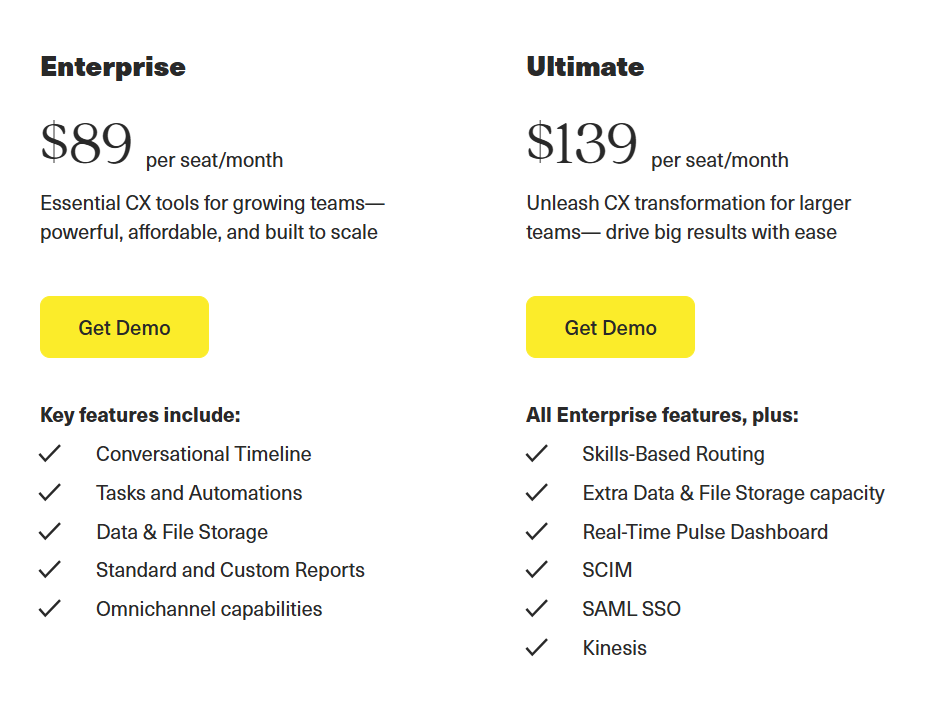
Image via Kustomer
Tool level
- Advanced to enterprise-level
Usability
- It requires training to understand CRM and automation features fully.
Pro tip: Experiment with AI-powered sentiment analysis and smart assist to enhance agent efficiency and customer experience.
Also Read:
FAQ
1. Who is Zendesk’s main competitor?
Zendesk’s main competitor is Freshdesk, known for its similar help desk functionality, intuitive interface, and flexible pricing. Other top Zendesk alternatives include timetoreply, Help Scout, Zoho Desk, Jira Service Management, and Salesforce Service Cloud.
2. Are there better Zendesk alternatives?
Yes, Zendesk alternatives like timetoreply, Freshdesk, Help Scout, and Zoho Desk may be better, depending on your needs. They offer lower costs, simpler interfaces, or deeper CRM integrations than Zendesk.
3. What are the disadvantages of Zendesk?
Zendesk can be expensive, has a steep learning curve, and its interface may feel overly technical. Additionally, customization options can be limited without advanced technical knowledge.
4. Are there free Zendesk alternatives?
Yes, Zendesk alternatives like Freshdesk and Zoho Desk offer free plans for basic customer service management features. If you need more advanced features, consider choosing Zendesk alternatives with affordable paid plans like timetoreply.
5. Is Zendesk a CRM or ERP?
Zendesk is a CRM tool specifically focused on customer service and support. It’s not an ERP system, which is designed to manage broader business operations, such as finance, inventory, and supply chain management.
6. What is Zendesk best used for?
Zendesk is ideal for managing customer service interactions. It offers multi-channel support, automates ticket workflows, and provides detailed analytics. It’s suitable for businesses seeking to streamline their support operations and improve customer satisfaction.
Also Read:
- The impact of delayed email responses on logistics customer service
- Email Analytics Alternatives: 7 Options for Business Email Analytics in 2025
Choosing the best Zendesk alternative: timetoreply
Zendesk is an excellent customer service platform for large companies. However, because it’s so feature-rich, it comes with a high price tag and will be overkill for most companies.
Depending on your needs, different Zendesk alternatives in this list will be a better fit than others.
If you need simplified Zendesk alternatives and are willing to move all your email activity onto a new platform, you might consider Front or Help Scout.
However, if you need Zendesk alternatives that:
- Give you market-leading email analytics and reporting
- Have ticketing features for your customer service and sales teams
- Have goal-setting features to motivate your team
- Built-in SLA management to track performance against client expectations
- Work on top of your existing email inboxes on Gmail and Outlook
Then, timetoreply is the only option for your business.
Looking for the best Zendesk alternatives? Try timetoreply for free.

